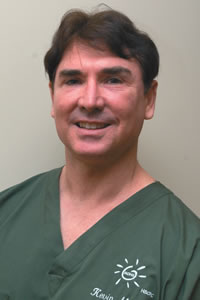
Sun Exposure And Aging Skin
February 18, 2009
By Dr. Kevin Mott


Dr. Kevin Mott
Dermatologist, Hawaii Skin Cancer and Photodamage Center
Interviewed by Melissa Moniz
Do you have an area of specialty?
I am a dermatologist with special training in dermatological surgery. My practice is entirely surgical and procedural.
What procedures do you commonly perform at the Hawaii Skin Cancer and Photodamage Center?
My practice focuses on the two main problems that sun exposure causes: skin cancers and photodamage or premature aging of the skin. Half my practice is devoted to removing skin cancers with a special method called Mohs micrographic surgery. This involves removing the skin cancer in very thin layers with meticulous control, and results in the highest cure rate with the least amount of tissue removed. Following removal of the skin cancers with the Mohs method, we are able to do whatever repair or reconstruction is necessary the same day to restore the patient to their original appearance as much as possible. The other half of my practice is devoted to improving and reversing the aging changes of the skin related to chronic sun exposure. The sun is recognized as the No. 1 cause of premature aging of the skin. This sun damage manifests itself as uneven tone with sun spots, broken blood vessels, wrinkles, skin laxity and leathery texture.
{embed=“elements/box_ad”}
To even out the skin tone due to sun damage, what types of treatments do you recommend?
Intense pulse light or IPL is used to even out sun spots, pigmentation and broken blood vessels. A vascular laser is used to target spider veins. Thermage is a radiofrequency treatment that tightens and stimulates collagen, improving skin laxity. I also use two different Reliant Fraxel lasers that work to restore and repair the skin. These lasers smooth out the skin surface and dramatically improve wrinkles and scars. Various injectable products such as Botox and fillers also are frequently used to fill in lines and wrinkles. All of these treatments can be used in almost any combination to address specific aging-related changes of the skin.
Is photodamage basically aging of the skin due to sun exposure, or is there a more defined meaning to the term?
Two types of aging mechanisms exist. Intrinsic aging is aging of the skin that would occur even if we were not exposed to the sun or other environmental insults. Extrinsic aging or photoaging is the premature and excessive aging changes due to sun exposure.
Besides sun exposure, what other factors affect photoaging?
Genetics, overall health, diet and health habits all play a role. Fairer skin is genetically predisposed to have relatively more damage to the skin with the same amount of sun exposure compared to a darker skin type. Patients with darker skin types have more natural protection and develop fewer skin cancers, but still develop aging-related changes such as wrinkling and leathery texture with excessive sun exposure. Therefore, sun protection is important for all skin types. People who have diets rich in antioxidants and low in fat tend to develop fewer aging-related changes in the skin. Certain disease states or medications can result in photosensitivity and can accelerate photoaging. Besides the regular use of sunscreen, other health behaviors can influence premature aging of the skin. Cigarette smoking, in particular, has devastating consequences when combined with excessive sun exposure.
For those who still insist on tanning, is it better to tan with natural sunlight at the beach or go to a tanning salon?
As the saying goes, there is no such thing as a safe tan. Tanning is actually an injury response of the skin that occurs to prevent further injury. The reason ultraviolet light is so damaging is that it is absorbed by and targets the DNA in your skin cells. This means that if you have been exposed to enough sunlight to generate a suntan, at the cellular level you have actually caused DNAmutation! Your skin cells actually stop dividing for 24 hours to repair the DNA damage. Not all DNA damage is reparable and can stay hidden for decades before progressing to forming a skin cancer. There are two types of utraviolet light. UVB is the burning wavelength (B for burn) while UVA is the aging wavelength (A for age). Both wavelengths are very damaging to skin. Although tanning beds often use a higher percentage of UVA light and claim that it is safer because of less burning, the fact is that there is still cellular injury. UVA light also penetrates more deeply into the skin reaching the collagen layer, and induces more of the premature aging-related changes of the skin.
{embed=“elements/google_ad336x280”}
What are some basic tips you offer your patients to prevent sun damage?
Because we have such strong sun year-round, I do recommend that people use protection every single day, whether they plan to be outside or not. Facial moisturizers with an SPF of 15 or more is a good place to start for the incidental daily exposure. Sun damage is additive and accumulates tremendously over a lifetime.
For direct exposure for long periods of time, I recommend using the physical sun-blocks that contain zinc and titanium. It also is important to realize that after two hours, sunscreens lose their rated level of protection and reapplication is necessary, especially for direct or constant sun exposure.